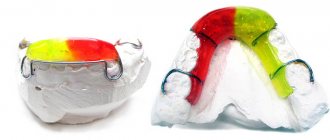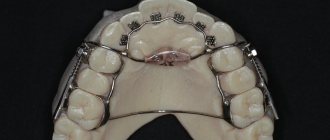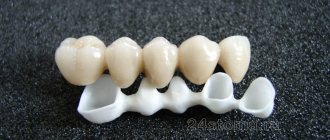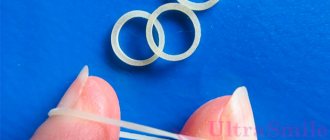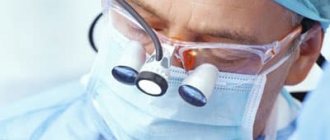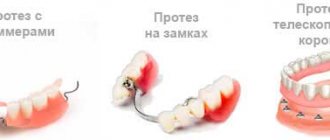6669
Modern orthodontics is designed to solve a person’s problems with the arrangement of individual teeth and the entire dentition as comfortably and quickly as possible.
Many patients are sure that only braces are used to straighten teeth, but this is not the case.
The Derichsweiler apparatus helps to expand the upper jaw and make a person’s smile smooth and beautiful.
Design and principle of operation
The Derichsweiler apparatus consists of elements :
- plate made of plastic or metal;
- metal screw;
- hooks, wire arches.
This design is located at the top of the palate, cast arches are attached to the side teeth, exerting pressure on them . The plate inside is equipped with a screw and metal fittings - hooks, which are fixed on the supporting molars.
Having securely fastened the device, the doctor looks at the effect it has on the teeth.
In addition to jaw expansion, there is also the movement of certain teeth that need correction.
During the treatment process, the design undergoes changes - a metal screw is tightened, which increases the area of the plate and increases the pressure.
The screw allows you to apply a gradually increasing load on the teeth, thereby fixing their displacement.
In addition to the problem of a narrow jaw, another, accompanying problem is solved - gaps between the teeth. As a result of pressure on the molars, incisors and premolars, these gaps are eliminated using springs and screws.
Indications for use
The Derichsweiler apparatus is necessary for patients who have the following problems :
- the upper jaw is too narrow, this is determined by the relationship between the upper and lower teeth, sometimes a person experiences difficulty chewing food, speaking and aesthetic discomfort;
- with crowding of molars, premolars in the upper jaw;
- in the presence of crossbite;
- if the fangs on the upper jaw grow incorrectly, out of place.
If these problems exist, dentists choose this particular device, as it allows you to effectively straighten your teeth in a short period of time .
Facebow
Used in adolescence in growing patients up to 12-13 years of age. The use of this device is effective in cases of predominant growth of the upper jaw and the goal of treatment on the face bow is to move the teeth in the upper jaw posteriorly.
Indications for use:
1. Distal bite. 2. Early loss of chewing milk teeth and displacement of the permanent 6 teeth. 3. To inhibit the growth of the upper jaw.
Wearing mode:
The orthodontist always recommends wearing it 24 hours a day. But in reality we're hoping for night, evening and weekend wear. Those. The face bow must be in the mouth for more than 12 hours a day.
Wearing period:
Most often, a facebow is prescribed together with a brace system (partial 4*2) or full. And it is used until the target is achieved (6-18 months).
Contraindications
The Derichsweiler apparatus is used up to the age of 20-23 years.
Its use is indicated for everyone who has the problems listed above. The only contraindication is an allergic reaction to metal or plastic that is part of the device.
It is not recommended to actively use it in case of cleft of the soft and hard palate, since with this defect an operation is performed to tighten the palatal suture, and the device just widens this suture.
In such a case, the treating orthodontist makes his verdict. After all, with this defect there are a lot of concomitant pathologies of tooth growth.
Advantages and disadvantages
In orthodontics, there are several methods for treating narrowness of the upper jaw.
But the Darichsweiler design has several advantages over them:
- the patient gets quick results, after a short treatment there is a noticeable expansion of the upper jaw;
- a person quickly gets used to the device, even if at first he experiences discomfort when wearing it;
- This device is used along with other methods of teeth straightening, for example, braces.
Using this mechanism, a person gets quick and high-quality results.
But when using it, patients sometimes experience complications. They are the disadvantage of this device.
When used in childhood, the child's palate may open. If you start treatment before the molars grow, you can avoid negative consequences.
This is due to the fact that in early childhood the palatine lobes have not yet completely fused, which allows for a good result to be achieved.
Advantages of the Marco Rosa device
The advantages of this orthodontic device include:
- High efficiency compared to removable structures (for example, Bertoni plate, Brückl-Reichenbach or Kois devices). The non-removable Marco Ross plate works around the clock, which reduces treatment time.
- No relapses. The molars erupt into the already prepared space, occupying the correct position.
- Comfort. The plastic base of the device is small in size, so it does not interfere with the mouth and is invisible to others.
- In addition to the expansion of the upper jaw, the Ross orthodontic apparatus ensures the normal development of the lower jaw.
- The use of this device in most cases eliminates the need for subsequent bite correction using braces.
- The Marco Rosa device, by expanding the nasal cavity, eliminates the syndrome of difficult nasal breathing.
- You can choose the color and design of plastic parts yourself. This increases the child’s motivation to wear the device.
- The device does not require special care; normal oral hygiene - brushing your teeth after meals and daily use of mouthwash or irrigator - is quite enough.
The only disadvantage of Dr. Ross’s device is, perhaps, its relatively high cost: the price of the standard version of the orthodontic device starts from 16,000 rubles.
Manufacturing process
To manufacture the device, you need to perform some manipulations with a doctor.
- At the first consultation, the specialist takes an impression of the teeth, which must be done very carefully, because the effectiveness of the treatment and the duration of the patient’s adaptation depend on this.
- First, the deepest part of the palate and torus is isolated, for which the doctor makes a gasket, no more than 4.5 mm in thickness.
- The interdental papillae of the gums and the front part of the palate are relieved of pressure.
- The plate itself is made of transparent plastic, which greatly facilitates the process of correction and monitoring the state of the sky under the plate.
- After fitting the device to the patient, the device is checked on a plaster model of the jaw, and the ability of the screw to work is assessed.
We will tell you how the Brückl-Reichenbach apparatus works in a separate article.
In this publication we will compare the appearance of diastemas before and after therapy.
Here https://orto-info.ru/sistemyi-vyiravnivaniya-zubov/breketyi/po-raspolozheniyu/vestibulyarnyie/victory.html you will find a review and photo of Victory braces.
Installation sequence
The accuracy of installation of the mechanism is important for the patient, because he will feel a foreign body in the oral cavity for at least another 3 months.
Treatment takes place in several stages:
- After checking the screw mechanism and adjusting the plate on the plaster jaw, the device is installed on the patient . The patient is given a day to master the device. At this time, he learns to use it and gets used to it.
- Then the patient, if nothing bothers him, has crowns and rings attached to his molars using special dental cement.
- 24 hours after fastening, the doctor begins the treatment process: the screw is unscrewed .
- Every day the screw is activated half a turn, the doctor and the patient monitor the condition of the device in the oral cavity and general well-being.
If the pain after turning the screw disappears within a minute, then you can continue treatment.
It is important not to overtighten the screw - this can lead to complications. If you add a little pressure, you may experience pain in the temples and bridge of the nose. In this case, the doctor returns the screw a little back.
After just a week, you can see the first result of the device - a diastema appears between the front teeth - a gap that grows and then goes away. There is a gradual alignment of the teeth.
Upon completion of treatment:
- the side teeth fall into place,
- the sky slightly increases its area,
- the lower part of the face visually becomes larger,
- the lower jaw falls into place,
- teeth align their position.
At what stage of bite correction is the Derichsweiler apparatus used, look at the video:
When the process of tightening the screw is completed, it is covered with a plastic plate for the patient’s convenience and to minimize discomfort.
Advantages and disadvantages
The advantages of using such a device include:
- the result is noticeable within two weeks;
- treatment time is shortened, the course usually takes about two months;
- no surgical intervention required;
- the correction is smooth, gradual, the effect is stable;
- adaptation to the product is fast;
- the design can be combined with others, for example, braces.
The disadvantages include age restrictions, the risk of rubbing the tongue on metal parts at first. In addition, the device will be effective only if installed during the period of jaw formation; effectiveness decreases after 18 years. After 23, this method of treatment is not used.
Installation sequence
To fix the structure, the following steps are used:
- inspection and diagnostics, selection of materials for manufacturing the structure;
- the supporting teeth are moved apart using separation rubber rings (at this stage the Patient feels slight discomfort and aching pain);
- at the second stage, the rings are removed, the dentist makes impressions for the manufacture of the device;
- After fitting, the structure is installed and the patient receives instructions on how to move the screws.
There are no particular complications during treatment, but slight discomfort may occur. It is important to follow a diet that excludes solid foods.
Price
The price of the Derichsweiler apparatus averages 8,500 rubles per design. The exact cost is influenced by the following factors:
- manufacturing materials;
- condition of the oral cavity;
- the need for preliminary treatment;
- complexity of the pathology, installation features.
About Us
My Ort Dentistry Clinic offers orthodontic services for children. We provide the following benefits:
- modern, fully equipped offices;
- comfortable conditions and attention to each Patient;
- qualified doctors;
- complex therapy, including diagnosis, treatment and prevention;
- favorable prices for therapeutic services.
We are waiting for you at the address: St. Petersburg, st. Yesenina, 1, building 1. We work seven days a week, you can make an appointment using a convenient form on the website or by phone.
How long to wear?
During the consultation, the orthodontist determines the approximate timing depending on the degree of anomaly in the position of the teeth.
The process of tightening the screw can last from a week to 2-3 months. It also depends on the age of the patient and the process of adaptation to the device. If any complications arise during treatment, more time will be required for alignment.
After tightening the screw, a period of retention follows - maintaining the achieved result . This is a very important time, because if it is not organized correctly, all efforts come to nothing.
The device stays in the oral cavity for a total of 2-3 months.
Duration of treatment
The duration of correction using the Derichsweiler device is determined by the specific defect and its severity. On average, therapy takes about 3 months.
Tightening the screw can last from one week to two or three months. This is followed by a retention period. It is necessary in order to consolidate the achieved results. The device is left in place, but the load is no longer increased.
The timing of treatment is affected by the age of the patient. The younger he is, the faster existing violations are corrected. If complications occur, the duration of therapy is always increased.
Possible complications
Complications during treatment with the Derichsweiler apparatus include dehiscence of the palate suture . This occurs due to weak tissues or too much pressure on the teeth. Sometimes it is difficult to adjust the position of the screw correctly.
The occurrence of persistent pain is also a complication of treatment with this device.
Features of the use of the Marco Rosa apparatus in Dial-Dent
Family Dental Orthodontists have a comprehensive approach to correcting malocclusion in children, so the clinic employs an ENT doctor and a speech therapist who help eliminate the causes of malocclusion, thereby increasing the effectiveness and stability of orthodontic treatment.
If there are problems with nasal breathing, ENT doctor A.V. is involved in treatment. Arkhandeev. The participation of an ENT specialist in orthodontic treatment is very important, since without normalization of nasal breathing, the treatment result will not be stable and no device will help!
If there is improper muscle function, incorrect position of the tongue, infantile swallowing, if the mouth is constantly open, even when breathing through the nose, a speech therapist - myofunctional therapist T.B. takes part in the treatment of children. Zukor. Classes with a speech therapist normalize the tone of the facial muscles, eliminate excessive pressure of the tongue on the teeth, normalize swallowing and breathing - that is, they remove factors that provoke malocclusion.
See the price list of the clinic for the cost of the Marco Rosa device.
Care instructions
Since the device is not removable, but is constantly in the oral cavity, it must be carefully looked after. Food debris accumulates between the wire and the teeth, forming plaque, which must be carefully cleaned with a medium-hard brush .
The patient periodically needs to visit the dentist or hygienist to clean all the hard-to-reach areas between the appliance and the teeth. The patient receives cleaning instructions each time a screw is tightened.
It is imperative to comply with the requirements for oral care, especially if other orthodontic systems are used together with the device.
In this case, it is better to rinse your mouth after each meal and not to eat hard, hard foods .
Derichsweiler apparatus manufacturing and installation
Step-by-step production and installation of the device:
- Before manufacturing and installing the drug, the doctor will need to slightly move the supporting teeth apart. To do this, special separation rings - rubber rings - are installed between the dental units. This procedure will take 5–10 minutes. The teeth will begin to shift, and the patient will initially feel aching pain. While wearing the rings, you should not eat astringent foods or chewing gum. If the rubber band falls out, you can install it yourself. To do this, you can use regular threads. Carefully install the elastic, stretching its edges.
- At the second stage, the doctor removes the rubber rings and creates an impression for the future design. After this, the rings are placed in their places. The period during which the system is being manufactured can be devoted to thorough teeth cleaning. The resulting gaps will just help you get to hard-to-reach places.
- After the design is made, it is tried on. If everything fits perfectly, the device is installed and fixed. The first tightening of the screw is performed by the doctor himself, selecting the optimal force of the structure on the jaw. Then the tightening procedure will be carried out by the patient himself. To do this, the doctor creates a specific schedule that must be adhered to. It is different for each patient. If we talk about average indicators, at first the procedure is repeated once every 3 days, then daily.
You can see the first results within 2–3 weeks. Do not forget that the gap formed at the suture site is filled with new bone mass; additional time is needed. The average period of wearing the device is six months.
What is the price?
All individual designs have a fairly high price, because they are not produced on a conveyor belt, which means that their production takes more time and effort. The price for each patient depends on several criteria :
- material for making plates, crowns and rings;
- region of residence of the patient;
- prices for doctor's services, which are determined for each medical institution.
After the inspection, the specialist can tell you the approximate price for the device.
The device itself can be purchased at a price of 8,500 rubles .
But the total cost will also include consultation with a specialist, manufacturing of the mechanism and its installation. In addition, the patient comes to tighten the screw, which is also paid for.
How does crossbite manifest in children and what are the differences in the methods of influencing it?
In this article, we will discuss how much teeth straightening trays cost and what factors influence the price.
At the link https://orto-info.ru/zubocheliustnye-anomalii/okklyuzii/glubokiy-prikus.html we published a selection of photos of how the face changes with a deep bite.
Price
On average, the cost of the device is 8,500 rubles. The price is high because the product is made individually for each patient. A doctor's consultation and work on installing and tightening the mechanism are paid separately. The cost of treatment is influenced by the patient’s region of residence and the pricing policy of a particular clinic.
In practice, it has been proven that the Derichsweiler device is one of the most effective methods for correcting a narrow upper jaw in young patients. That is why the method is widely used in orthodontics.

